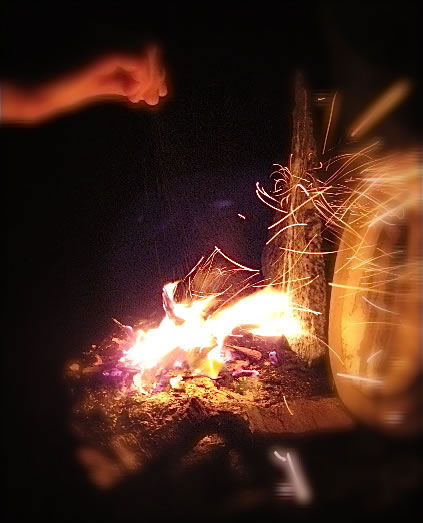FLINT + SPARK = FLAME ON! THE ETYMOLOGY OF BRAND, INNOVATION, CULTURE + FIRE

BRANDFIRE | THE ENTERPRISES THAT ARE FIRED BY PASSION
As a designer, presuming strategic intention, the practice of designing — buildings, print, objects — is never about what’s on the surface alone, but more to what lies beneath and within. Soul would be, for a designer — that journey of within: soul-finding — the work of finding the heart of the story, the telling, the offer, the pathway. What’s inside — as you design — what is the contemplation into the work, the making?
Beauty comes to mind — making beauty, the quest for betterment, the finding of the good thing, the right telling — the appropriate feel, the touch of the rightful place. Design is more than smart organization, content well structured, a pretty building, nice site, well-ordered catalog. But the deeper intention of a brand — the enterprise of designing towards something — all ways has a soul — it’s the whole integration of the humanity of the work; it’s not just an exercise; there’s something inside that’s more than just prettying. It’s resonance — the offering is relevance, it’s needful, but there is a heartfulness to the offer, to the story, to the place-made whether it’s a digitalistic pixelated place-making; or it’s a built place — was a space, now there’s a character, there is something more.
That’s what we’re looking for.
The more.
The Light of effort at
the top of the wave of work.

The legacy of any design decision lies in historical experience — it is about the story of what has been, what story might be told now, and how that story could extend to the future. That’s human-made, the nature of the soul-full-ness is about the humanity of the attributes of making — plans, designs, projections, products, packages.
There is
more
to it.
For each of us, exploring the idea of design might be to the link of the signature — the “signing” of a solution in the original use of the word. For every design might be just that, regardless of the transparency of interpretation, it is a filtration of personal spirit and character.
In reaching into the heart of the translation of design, the center of a relationship — the challenge of finding a solution — the spirit of the designer, the signature will be seen. Anyone committed to the ethos of creativity will reach into the soul of experience, and expertise, to bring forth something that is profound in the power of solution. That sense of soul driving the path to the answer will be about passion.
Passion is fire. Passion is pain. Passion is empathy — the feelingness: reaching into the heart of a relationship, to a problem, an idea, a question that is holistically embraced.
You’re wholly in.
Or you’re out.
That sense of embrace will mean more to the sentiment of captivation, the sentience of commitment, being consistently driven to get closer to the flame of the challenge that is set, to seek the exhilarating freedom of the ideal response.
That is the quest of life — go deeper, go further, go in, get underneath.
But that response will always be tinted by the person that creates that answer. Surely, in any design problem, there will be consistency in understanding the issues at stake, the nature of the question, the character of the audience, who’s listening to the story, how it’s to be best told — but always, in the end, the spirit of the finding the actual signature of the outcome will be touched by personality.
The hand draws from the soul.
That idea of fire is a compelling patterning in my experience, working with leaders from around the world — who, in that game, is really in it? Who is really entranced by the problem that needs to be seen, in scene, and newly discovered.
The person in front — the one who leads — needs to be inflamed with that sense of profound and continuing commitment to explore the nature of the pathway to the design answer, but as well, what lies beneath that exploration of discovering. Every answer yields another question — and then another answer. As a person that focuses on the brand as a form of communicating to relationships, the ideal leader is one that touches and contemplates every detail of that resolution; it’s not the glancing overview, but the details that make this approach to enterprise memorable.
To think about the concept of brand, it’s important to toss out the conventional definition of what that trapping means — 1957 = David Ogilvy, and go beneath, into the primordial history of words.
Brand, the word, is first spoken at least 4,000 years ago — its etymology is embedded deep in the roots of Indo European language — and there, in the beginning, the spirit of the word is fire. The translation of this expression really only found its home in the west during the last millennium, first scribed in a monastery off the coast of Scotland, a refuge from the battery of that tumultuous time.
In working on brands, my work is always with the leadership of that brand — and in that entwining, the idea of brand and the human spirit that lies in the heart of it — there is a kind of genetic mingling. The human brand. And in most of the powerful brand stories that are attached to the presentation of design as a key ethos of value, the human leadership is the fire that burns at the soul of that encounter.
In the early days of my career, then successively afterwards, I was exposed, firsthand, to Steve Jobs — working at Apple. While some of the team then defined Steve as a terrorist, for me that opening encounter was about passion — always intensity — and the fire of the details in getting things right, down to the microscopic shading of a industrial design detail, the form language of a returning curve of an object, a screen interface, or the touch of handcrafted typography. That initial encounter lead to others at Apple in which the same passion — the fire of the brand, that sparks and ignites that inspiration — is voiced in everything. You are either part of the flame, or you are extinguished by it.
So too in speaking with designer Tom Ford — a man in which every detail of the Tom Ford brand has a sense of the touch of his passionate fire. He designs to create what he doesn’t see in the market — and what he wants to see in the market. He designs, literally, for himself. That fire is a blazing trail — a signature. And finding that opening, the obsession to create, is something that continuously empowers every decision of experience.
Anyone who works at Apple, or at Tom Ford, or any culture of brandfire, will tell you the selfsame truth — the power of the brand story is about that fire of a flammable signature; each touch — a gesture of fire.
Tim | Nosara, Costa Rica
B R A N D M Y S T I C I S M
Deep Journeys to Team & Enterprise
D i s c o v e r y: http://goo.gl/DNfwS9
HUMANS, BRANDING + H E A R T
BRANDQUEST®
BrandJourneys®
http://goo.gl/iyQIzK
Well done this is when people identify themselves with the company.
there is one german meaning
Wenn du glaubst etwas zu sein hast du aufgehört etwas zu werden.
Hey Fred — I missed your comment, and I was a student of German, so I grasp your added commentary. Thanks for the share. Passion — that’s the heart of a successful enterprise.